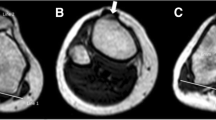Abstract
Purpose
Excessive tibial tuberosity–trochlear groove distance (TT–TG) is considered as one of the major risk factors in patellofemoral instability (PFI). TT–TG characterises the lateralisation of the tibial tuberosity and the medialisation of the trochlear groove in the case of trochlear dysplasia. The aim of this study was to assess the inter- and intraobserver reliability of the measurement of TT–TG dependent on the grade of trochlear dysplasia.
Methods
Magnetic resonance imaging (MRI) scans of 99 consecutive knee joints were analysed retrospectively. Hereof, 61 knee joints presented with a history of PFI and 38 had no symptoms of PFI. After synopsis of the axial MRI scans with true lateral radiographs of the knee, the 61 knees presenting with PFI were assessed in terms of trochlear dysplasia. The knees were distributed according to the four-type classification system described by Dejour.
Results
Regarding interobserver correlation for the measurements of TT–TG in trochlear dysplasia, we found r = 0.89 (type A), r = 0.90 (type B), r = 0.74 (type C) and 0.62 (type D) for Pearson’s correlation coefficient. Regarding intraobserver correlation, we calculated r = 0.89 (type A), r = 0.91 (type B), r = 0.77 (type C) and r = 0.71 (type D), respectively. Pearson’s correlation coefficient for the measurement of TT–TG in normal knees resulted in r = 0.87 for interobserver correlation and r = 0.90 for intraobserver correlation.
Conclusion
Decreasing inter- and intraobserver correlation for the measurement of TT–TG with increasing severity of trochlear dysplasia was detected. In our opinion, the measurement of TT–TG is of significance in low-grade trochlear dysplasia. The final decision to perform a distal realignment procedure based on a pathological TT–TG in the presence of high-grade trochlear dysplasia should be reassessed properly.
Level of evidence
Retrospective study, Level II.



Similar content being viewed by others
References
Alemparte J, Ekdahl M, Burnier L, Hernandez R, Cardemil A, Cielo R, Danilla S (2000) Patellofemoral evaluation with radiographs and computed tomography scans in 60 knees of asymptomatic subjects. Arthroscopy 23(2):170–177
Camp CL, Stuart MJ, Krych AJ, Levy BA, Bond JR, Collins MS, Dahm DL (2013) CT and MRI measurements of tibial tubercule-trochlear groove distances are not equivalent in patients with patellar instability. Am J Sports Med 41(8):1835–1840
Dejour D, Saggin P (2010) The sulcus deepening trochleoplasty—the Lyon’s procedure. Int Orthop 34(2):311–316
Dejour H, Walch G, Nove-Josserand L, Guier CH (1994) Factors of patellar instability: an anatomic radiographic study. Knee Surg Sports Traumatol Arthrosc 2:19–26
Dietrich TJ, Betz M, Pfirrmann CW, Koch PP, Fucentese SF (2014) End-stage extension and its influence on the tibial tuberosity-trochlear groove distance (TT–TG) in asymptomatic volunteers. Knee Surg Sports Traumatol Arthrosc 22(1):214–218
Howells NR, Barnett AJ, Ahearn N, Ansari A, Eldrige JD (2012) Medial patellofemoral ligament reconstruction. A prospective outcome assessment of a large single centre series. J Bone Joint Surg Br 94(12):1655–1659
Koeter S, Diks MJF, Anderson PG, Wymenga AB (2007) A modified tibial tubercle osteotomy for patellar maltracking. J Bone Joint Surg Br 89(2):180–185
McNally EG, Osterle SJ, Pal C (2000) Assessment of patellar maltracking using combined static and dynamic MRI. Eur Radiol 10:1051–1055
Monk AP, Doll HA Gibbons CLMH, Osterle S, Beard DJ, Gill HD, Murray DW (2011). The patho-anatomy of patellofemoral subluxation. J Bone Joint Surg Br 93-B:1341–1347
Nelitz M, Lippacher S, Reichel H, Dornacher D (2014) Evaluation of trochlear dysplasia using MRI: correlation between the classification system of Dejour and objective parameters of trochlear dysplasia. Knee Surg Sports Traumatol Arthrosc 22(1):120–127
Pandit S, Frampton C, Stoddart J, Lynskey T (2001) Magnetic resonance imaging assessment of tibial tuberosity-trochlear groove distance: normal values for males and females. Int Orthop 35(12):1799–1803
Pfirrmann CW, Zanetti M, Romero J, Hodler J (2000) Femoral trochlear dysplasia: MR findings. Radiology 216(3):858–864
Schoettle PB, Zanetti M, Seifert B, Pfirrmann CW, Fucentese SF, Romero J (2006) The tibial tuberosity-trochlear groove distance; a comparative study between CT and MRI scanning. Knee 13(1):26–31
Stäubli HU, Dürrenmatt U, Porcellini B, Rauschning W (1999) Anatomy and surface geometry of the patellofemoral joint in the axial plane. J Bone Joint Surg Br 81(3):452–458
Tecklenburg K, Feller JA, Whitehead TS, Webster KE, Elzarka A (2010) Outcome of surgery for recurrent patellar dislocation based on the distance of the tibial tuberosity to the trochlear groove. J Bone Joint Surg Br 92(10):1376–1380
Wittstein JR, Bartlett EC, Easterbrook J, Byrd JC (2006) Magnetic resonance imaging evaluation of patellofemoral malalignment. Arthroscopy 22(6):643–649
Author information
Authors and Affiliations
Corresponding author
Rights and permissions
About this article
Cite this article
Dornacher, D., Reichel, H. & Lippacher, S. Measurement of tibial tuberosity–trochlear groove distance: evaluation of inter- and intraobserver correlation dependent on the severity of trochlear dysplasia. Knee Surg Sports Traumatol Arthrosc 22, 2382–2387 (2014). https://doi.org/10.1007/s00167-014-3083-5
Received:
Accepted:
Published:
Issue Date:
DOI: https://doi.org/10.1007/s00167-014-3083-5




